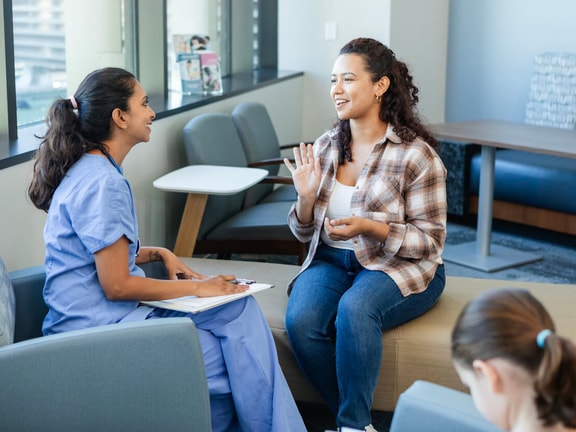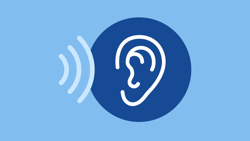Active Listening in Healthcare: What Clinicians Can Learn from Improv
Strengthen your patient interactions with the power of active listening in healthcare. This article explores evidence-based strategies and improv-inspired tools to help you tune in, build trust, and improve outcomes.
July 24, 2025
7 min. read

Active listening in healthcare is the skill of genuinely hearing, processing, and responding with intention. It’s what makes someone a great improviser—and an even better care provider. It helps patients feel more comfortable, builds trust, and has even been shown to activate the brain’s reward system. In short, it helps everything flow more smoothly.
When it comes to patient interactions, what we listen to is just as important as what we say. In fact, one of the core ideas behind improv comedy in healthcare is that listening (not just reacting) is what keeps the conversation moving forward. The improv principle of "Yes, And" is a powerful way to help patients open up and feel more understood, but without active listening, it falls flat. “Yes, And” only works when we’re fully tuned in to what the other person is saying.
Let’s explore how active listening can strengthen your patient interactions and how improv techniques can help you sharpen that skill.
Hearing vs. listening: There’s a difference
There’s a big difference between hearing and listening—and in healthcare, that distinction matters.
Hearing is passive. It’s taking in sounds without intention: a patient’s voice, a car horn outside, a dog barking down the street. You hear them, but you don’t process what they mean. The sound happens, and then it’s gone.
Listening is active. It requires curiosity and attention. You’re not just registering sound. You’re trying to understand why it’s being shared. What’s the meaning behind the words? What’s motivating the story?
And that’s really at the heart of active listening in healthcare. When a patient starts talking about a movie they watched instead of answering your question directly, it may seem off-topic, but often, there’s a reason. The story might contain a clue about how they’re feeling, what they value, or even something medically relevant. It could also mean they simply feel safe enough with you to open up in their own way.
Instead of redirecting too quickly, take a moment to really listen. There may be more beneath the surface than you think, and patients often reveal what they need when we give them space to tell their story.
Team-based listening: The improv mindset
In improv, listening is one of the most important tools a performer has. Great improvisers don’t just wait for their turn to talk. They actively tune in, process what’s happening in real time, and respond with intention. This quick back-and-forth creates a rhythm that feels natural and collaborative, like a volley in tennis. It’s a balance of give and take.1
That same mindset applies to active listening in healthcare. When you listen with the goal of truly understanding your patient (not just checking off a box), you become part of the same team. It’s no longer just you leading the appointment; it’s a shared effort built on trust, curiosity, and human connection. This is what patient-centered care looks like in action.
And like in improv, communication isn’t just verbal. Eye contact, posture, and facial expression all play a role in how our messages are received. In both settings, eye contact is especially powerful. On stage, it helps improvisers build trust and stay in sync. In the clinic, it helps patients feel heard.
Looking up from your computer and making eye contact may seem small, but it makes a real difference. Studies show that eye contact improves patient trust and even helps providers pick up on subtle, unspoken cues.2 It’s a simple habit with an outsized impact—one that reinforces the relational side of clinical care.
Avoiding assumptions: Don’t lead the scene
Making assumptions can throw the whole improv scene off track. You never quite know where your scene partner is going, so if you decide too soon, you risk missing the bigger picture. The story might take a different direction, and if you’re not listening closely, you’ll miss your cue.
The same holds true in healthcare. When we assume we know what a patient means or dismiss part of their story as irrelevant, we risk overlooking important clinical details. This can lead to delayed diagnoses, gaps in care, or inappropriate discharge decisions, especially in fast-paced or acute settings.
Active listening in healthcare means staying open, curious, and ready to follow the patient's lead. It’s about gathering information without steering the conversation too soon.
One way to practice this is by shifting the types of questions we ask. Closed or leading questions (like “Where is the pain?”) can limit the patient’s response or force them into a framework that doesn’t match their experience. A patient might not even describe their main symptom as “pain” but may default to that answer because it seems like what you're expecting.
Instead, open-ended questions create space for clarity:
“How would you describe your symptoms?”
This small change keeps the conversation collaborative. Like in improv, it keeps the scene alive and gives the other person the freedom to contribute fully. And when patients feel safe to share in their own words, we’re better positioned to deliver the care they actually need.
Listening changes the brain
Active listening in healthcare isn’t just a polite communication habit. It has real biological effects.
A 2015 study using functional MRI found that when people felt they were being actively listened to, their brains showed increased activation in areas linked to reward and emotional regulation.³ In simple terms, the brain treated active listening like a positive experience, something rewarding and validating.
This reinforces what many providers already know intuitively: Listening isn’t just about gathering information. It’s a therapeutic act. When patients feel truly heard, it can change how they view their care, their recovery, and even their relationship with themselves.
Active listening doesn’t just make conversations smoother. It helps patients feel safer, more valued, and more likely to stay engaged in their care.
And Scene!
When people watch improv, they often assume the best performers are the funniest. But in reality, it’s the best listeners who make the scene work. Great improvisers tune in, respond with authenticity, and make their partners look good. That’s what makes the magic feel seamless.
The same goes for healthcare providers. The most impactful clinicians aren’t always the ones with the most to say—they’re the ones who know how to listen. When we practice active listening in healthcare, we build trust, reduce misunderstandings, and make patients feel seen and supported. We also uncover clinical details we might have otherwise missed.
It’s a simple act with powerful ripple effects. From stronger patient relationships to better outcomes, active listening might be one of the most effective—and underrated—tools in your clinical toolkit.
References
Besser M, Roberts I, Matt Aut Walsh, et al. The Upright Citizens Brigade Comedy Improvisation Manual. Comedy Council Of Nicea, LLC; 2013.
MacDonald K. Patient–clinician eye contact: Social neuroscience and art of clinical engagement. Postgraduate Medicine. 2009;121(4):136-144. https://www.tandfonline.com/doi/abs/10.3810/pgm.2009.07.2039
Kawamichi H, Yoshihara K, Sasaki AT, et al. Perceiving active listening activates the reward system and improves the impression of relevant experiences. Social Neuroscience. 2015;10(1):16-26. https://www.tandfonline.com/doi/full/10.1080/17470919.2014.954732
Below, watch Dawn Clifford discuss reflective listening this brief clip from her Medbridge course "Motivational Interviewing: Mastering Active Listening."






